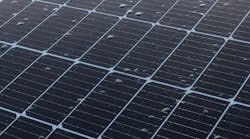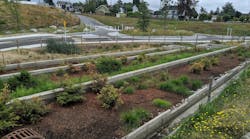In several editorials and blogs over the last few years, I’ve mentioned the problem of plastics and other debris in our water bodies. Plastic in the oceans gets a lot of attention, from the Texas-sized Great Pacific Garbage Patch to the many other swirling masses of debris out there. One environmental organization fighting the problem, 5 Gyres, even takes its name from them.
Almost all of the debris in the oceans originates on land, of course, carried (or so most people have assumed) in runoff to rivers and eventually to the sea. And although it’s a water-quality issue, much of it has been hard for the stormwater management community to do anything about, at least directly. It’s not only discarded trash that’s making its way to the waters; tiny but insidious bits of plastic also come from industrial sources (the small plastic pellets called “nurdles” that are used in the manufacture of plastic goods) and from wastewater. Recently the issue of miniscule plastic beads used in many personal care products—skin exfoliants and toothpastes, for example—came to the public’s attention in a big way; wastewater treatment plants don’t capture them, so they slip through to lakes, rivers, oceans—and into the food chain. In this case, faced with pending legislation in some states to outlaw the plastic beads, many manufacturers began substituting other ingredients like degradable microcrystalline cellulose instead.
Parts of the debris problem, though, do lie squarely within our purview, and, with a little help, there is something we can do about it. The article on page 22 of this issue reports on an innovative study, carried out jointly over several years by a city and a nonprofit organization, to figure out just what we’re dealing with, where it’s coming from, and how it’s traveling, which in turn can help tremendously in targeting source control efforts. And although trash characterization studies are not uncommon, this one puts a slightly different spin on the process.
The city—Los Angeles—has several total maximum daily loads (TMDLs) in place for trash, stemming from a 1999 lawsuit and consent decree, so it had strong incentive to take action. It found that although physical barriers like catch basin screens and inserts, belowground separators, netting systems, and low-flow diversions were having an effect, they weren’t going to get the city what the TMDL said it needed to have, which is essentially no trash at all in the river.
A nonprofit organization, Friends of the Los Angeles River, holds a regular event called the Great Los Angeles River Cleanup, which brings volunteers out to gather trash from the banks of more than 50 miles of urban river. It began characterizing the trash it collected, labeling it by location and by type. The city, meanwhile, was conducting studies of its own, collecting and characterizing trash from various land-use areas. Comparing results, the city and the nonprofit found vastly different types of trash in or near water versus on land. The results indicate that trash is carried to the river not only by stormwater runoff but also, significantly, by wind—especially lightweight items like plastic bags and wrappers—and through direct dumping into the water—mostly larger items like mattresses and shopping carts.
The upshot of all this is a shift in Los Angeles to focus not only on the physical barriers like screens and catch basin inserts—which after all can catch only what’s already in the runoff stream—but also on source control: public education, legislative approaches, stronger enforcement of laws against illegal dumping, better targeting of trash in public spaces like parks. Some cities faced with similar results might consider launching or increasing their street sweeping programs as well. A growing number are already enacting bans on plastic shopping bags.
The results of the study in LA show that stormwater departments most likely can’t solve the trash problem on their own. But if stormwater departments in other cities push for similar studies, it might help the public and elected officials understand the real scope of the problem and the variety of options—more than we think—to solve it.
About the Author
Janice Kaspersen
Janice Kaspersen is the former editor of Erosion Control and Stormwater magazines.


